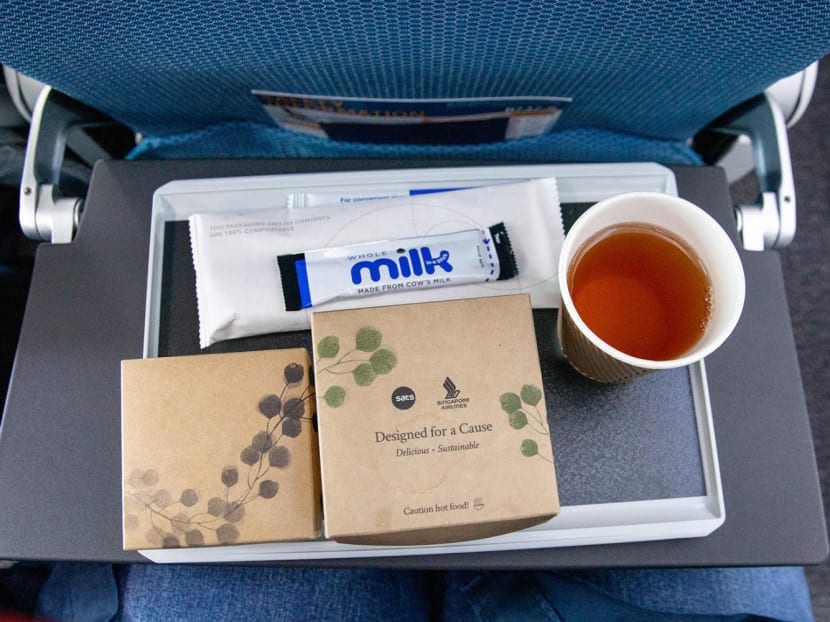Analysis: After public image 'blip' and record profits, what challenges await SIA?
SINGAPORE — Recent negative feedback surrounding its inflight dining experience is but a short-term dent on the premium image of Singapore Airlines (SIA), aviation and branding experts said, adding that the national carrier’s brand continues to be an invaluable asset for the company.

The interior of a Singapore Airlines plane.
- Singapore Airlines recently had to grapple with negative public sentiments over changes in its inflight-dining service
- This came around the same time it reported record annual profits
- Business and industry experts said there may be a temporary stain to its image but its premium brand is a key long-term asset
- The airline's outstanding financial performance may not be long term though, owing to a challenging operating environment
- The airline should continue to grow its financial strength and strategic agility, and build upon its premium customer experience, they added
SINGAPORE — Recent negative feedback surrounding its inflight dining experience is but a short-term dent on the premium image of Singapore Airlines (SIA), aviation and branding experts said, adding that the national carrier’s brand continues to be an invaluable asset for the company.
It is important that the airline builds upon this asset as it navigates the challenging post-Covid-19 environment, because even remarkable gains such as its record annual profit may not be sustainable in the long term, they cautioned.
The analysts were speaking to TODAY after the airline reported last month that it had a record annual profit of S$2.16 billion — reversing three straight years of losses — driven by strong demand for air travel that boosted revenue.
TODAY delved into what the recent negative feedback and remarkable financial gains mean for SIA, the potential challenges that may lie ahead and what it needs to do to navigate them.
WHAT EXPERTS SAY OF SIA’S RECENT DEVELOPMENTS
The recent brouhaha over its inflight service revolved around the trial usage of paper ware to serve some main courses and the removal of some items from certain meals, which some camps viewed as cost-cutting measures and deteriorating service standards on the part of the airline.
SIA has since reversed those actions, with its chief coming out to acknowledge them as lessons learnt and that the airline could have "reacted faster" in response.
Industry observers such as Mr Alfred Chua, editor of Asia air transport at trade media FlightGlobal, said that dealing with customer backlash is not unique to SIA, noting for example how Qantas Airlines was beleaguered with operational issues last year that stoked the ire of its customers.
The Sydney Morning Herald in March reported that the number of complaints against Qantas rose 68 per cent in the 2022 financial year.
Ms Umah Devi, manager at the school of business management at Nanyang Polytechnic (NYP), found SIA’s recovery steps commendable.
“If it can keep up its responsiveness and open tone, I think this is just a blip in SIA’s reputation and will not have a long-lasting impact on its brand positioning and narrative as one of the world’s top airlines,” she added.
Mr Frederick Tong, group strategy director at Ogilvy Singapore, said that the recent issues can be fixed relatively quickly. In the meantime, building a strong brand would take time and more effort.
“But (such efforts) are well worth it because they insulate against minor blips. SIA's premium brand remains a key asset, and the emotional connection people have with the brand will continue to hold,” Mr Tong added.
Building upon this strength is particularly important as the airline navigates cloudy skies, even from a position of financial strength.
Mr Chua from FlightGlobal reckoned that SIA “can carry on this momentum in the short term”.
“Because there is still, at least in the Asia-Pacific region, a lot of pent-up demand that it can tap.”
Another observer believes that the momentum is unsustainable and "one-off". Mr Shukor Yusof, founder of advisory firm of Endau Analytics, said that this is because it was "a result of the pandemic creating an unusual demand for air travel" after border restrictions were lifted.
Conditions beyond SIA's control, such as geopolitical uncertainties, make it more "unlikely" for the momentum to sustain, he added.
Experts such as Singapore-based independent aviation analyst Brendan Sobie generally agreed as well that SIA’s exceptional gains would not necessarily continue in the long term.
“Its current financial performance (last fiscal year and current quarter) indeed should be viewed as temporary,” Mr Sobie said.
“There has been no permanent structural change in the industry or permanent changes in market conditions.”
WHAT SIA IS UP AGAINST IN REGAINING GROUND
The International Air Transport Association last December projected that the global airline industry will return to profitability this year, while costs are expected to keep going up.
Mr Joshua Ng, director at consultancy firm Alton Aviation, highlighted two particular cost factors affecting SIA.
“Singapore’s labour costs have been higher than our neighbours, and the inflation we have seen over the last year will put even more pressure on SIA’s profitability,” he said.
Secondly, Singapore is “one of the leading voices in Asia” in terms of sustainability and would be particularly affected by the high costs of sustainable fuel.
“From a cost-recovery perspective, SIA will be challenged in trying to recover the higher costs from passengers, while competing against other airlines that might not be subject to the same requirements (of sustainability goals),” he added.
"From a travel demand perspective, higher fares will likely reduce demand. SIA will have a balancing act of maintaining traffic growth."

Yet another challenge that SIA faces in maintaining its recent fiscal achievement would be the intensifying competition from other players.
“As the world normalises following the pandemic, we expect other Asian airlines, particularly Chinese (including Hong Kong) and Japanese airlines, to build momentum and take back the share that they have lost to SIA,” Mr Ng said.
SIA’s branding, though an asset, may also bring about its own set of challenges.
Mr Shukor of Endau Analytics said that SIA’s dependence on premium positioning may work against it as more passengers and corporations are becoming "more price-sensitive”.
Passengers paying a premium for the airlines’ services will likely decline during a period of prolonged global instability.
Mr Chua of FlightGlobal said that after not being able to travel for a long time, “the travelling public are a bit more aware of what they want, and what they don't want, and the expectations are a little bit higher”.
While this applies to all airlines in general, an airline with premium positioning such as SIA tends to be subject to greater scrutiny, the industry experts said.
Mr Chua also said that being the national carrier, SIA has to grapple with greater expectations from Singaporeans.
“For airlines, satisfying the goals of meeting customer expectations and meeting financial goals are not always at odds with each other.Mr Joshua Ng, director at consultancy firm Alton Aviation”
WHAT SIA SHOULD DO
For SIA to soar higher, the analysts identified a few things that it should do.
As with any business, maintaining strong financial health and building up liquidity is important for any company to weather possible crises, and SIA is no exception to the rule.
Mr Abbas Ismail, chair of the diploma in aviation management course at Temasek Polytechnic, said: “We can see that SIA has taken the time during the pandemic to relook at processes so that it can become more efficient, and some of these efficiencies have affected the bottom line in a positive way.”
However, a long-drawn crisis — much like Covid-19 — could put to the test any airline’s preparedness, both financially and in terms of planning.
“People thought Covid-19 was going to be half a year, but it turned out to be more than two years,” Mr Chua said.
He added that what Covid-19 has taught some industry leaders is that “any amount of forward planning can sometimes just become nothing” in the face of prolonged crisis and uncertainties.
This is where being agile is important.
Some airlines, such as those in North Asia, “very quickly shift to cargo-focused operations” to try to stay afloat financially, for instance.
Mr Abbas of Temasek Polytechnic said that such agility and flexibility can even extend to managing manpower.
“One area that is important is the need to be flexible in hiring and retaining workers. As we can see, every airport and airline in the world is suffering the same manpower shortage now and that is hampering recovery efforts and profitability for most.”
Mr Abbas suggested that SIA work with relevant Singapore companies for ground work or institutes of higher learning here to broker collaborations that train and enhance workers’ skill sets in preparation for future pandemics.
Agreeing, Mr Calvin Loo, manager at NYP’s school of business management, said: “When ‘people’ are the key components for a service-led organisation, constantly upgrading the competencies of its employees will also enhance the organisation’s competitive edge moving forward.”
And last but not least, SIA must continue keeping in tune to its customer's needs, building upon its long-established positioning of offering a premium experience to travellers.
“This involves investing in new technologies such as artificial intelligence, innovative seating and new entertainment options, as well as expanding its network or exploring new markets,” Mr Loo from NYP said.
Generally speaking, maintaining high levels of service may sound like a costly endeavour.
“(However), for airlines, satisfying the goals of meeting customer expectations and meeting financial goals are not always at odds with each other,” Mr Ng from Alton Aviation said.
Agreeing, Ms Devi from NYP said: “Enhancing this experience is pivotal in fostering customer loyalty, positive word-of-mouth, and sustainable competitive advantage.”
At the end of the day, putting in money to build up a premium experience for its passengers may just be an investment that would pay for itself.
“Business travellers and wealthy individuals who purchase premium services tend to be more price-inelastic compared to leisure travellers, and SIA would be more likely to recover the rising costs without affecting demand,” Mr Ng said.











